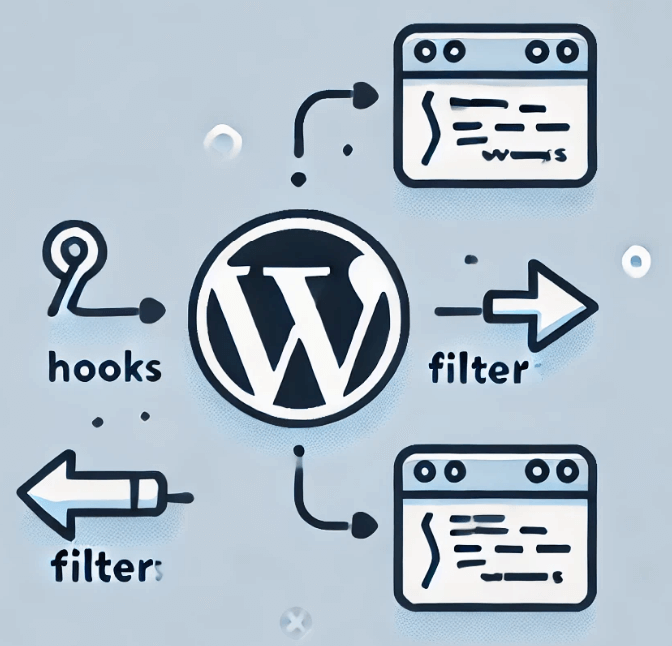Hooks are one of the most powerful features of WordPress, allowing developers to modify or extend the core functionality without altering WordPress itself. Custom hooks and filters provide a way for plugins to communicate with WordPress and other plugins. In this guide, you’ll learn how to create custom action hooks and filters in your WordPress plugins to enhance flexibility and maintain clean code.
Understanding Actions vs Filters
- Action Hooks: Allow developers to execute custom code at specific points during the WordPress execution.
- Filter Hooks: Allow the modification of data before it is processed or displayed by WordPress.
WordPress provides built-in hooks, but creating custom hooks in your plugins allows others (or yourself) to modify your plugin’s behavior without changing the core code.
Creating a Custom Action Hook
Let’s create a custom action hook in a simple plugin. Action hooks run a specific function when called.
Example Plugin Code
Create a new file called my-custom-plugin.php:
<?php
/*
Plugin Name: My Custom Plugin
Description: A demo plugin with custom hooks.
Version: 1.0
Author: Your Name
*/
// Create a custom action hook
function my_custom_action() {
do_action('my_custom_action_hook');
}
// Call the hook in a function
function display_custom_message() {
echo "<p>This is a message from the custom action hook!</p>";
}
// Attach a function to the custom action hook
add_action('my_custom_action_hook', 'display_custom_message');
// Trigger the custom action hook
add_action('wp_footer', 'my_custom_action'); // Runs the hook in the footer
?>
In this example:
do_action('my_custom_action_hook')defines a custom action hook.add_action('my_custom_action_hook', 'display_custom_message')attaches the function to the hook.- The hook is triggered in the footer with
add_action('wp_footer', 'my_custom_action').
Know more: Top WordPress Security Plugins
Creating a Custom Filter Hook
Filters modify data passed through them and return it. Let’s create a custom filter to modify a text message.
Example Plugin Code
<?php
/*
Plugin Name: My Custom Filter Plugin
Description: A demo plugin with custom filters.
Version: 1.0
Author: Your Name
*/
// Create a function with a custom filter
function get_custom_message($message) {
return apply_filters('custom_message_filter', $message);
}
// Use the custom filter to modify the message
add_filter('custom_message_filter', function($message) {
return $message . " - Modified by Custom Filter";
});
// Trigger the custom filter
function show_filtered_message() {
$message = "Hello, world!";
echo get_custom_message($message);
}
add_action('wp_footer', 'show_filtered_message');
?>
In this example:apply_filters('custom_message_filter', $message)defines a custom filter.add_filter()attaches a function that modifies the message.- The modified message is displayed in the footer using
add_action().
Read about: Setting Up WooCommerce Webhooks
Using Parameters with Custom Hooks
You can pass parameters to your custom hooks to make them more dynamic.
Example with Parameters
// Action hook with parameters
do_action('my_custom_action_with_params', 'John Doe', 'Welcome to WordPress');
// Function to handle parameters
function greet_user($name, $message) {
echo "<p>$message, $name!</p>";
}
add_action('my_custom_action_with_params', 'greet_user', 10, 2);
The 10 represents the priority, and 2 indicates the number of parameters.
Best Practices for Custom Hooks
Document Your Hooks: Include comments to describe how your hooks work so others can use them effectively.
Use Unique Names: Avoid naming conflicts by prefixing your hooks with your plugin name or namespace.
Keep Hooks Modular: Use hooks to keep your code flexible and easy to maintain.
Avoid Hardcoding Functions: Let users attach their own functions via hooks instead of hardcoding logic.
Find out: How to Transfer WordPress from Local Server to a Live Site
When to Use Custom Hooks
- Modifying Plugin Output: Allow users to customize text or HTML output.
- Triggering Events: Use hooks to run code when certain actions occur, like form submissions or post creation.
- Extending Plugin Functionality: Create hooks to allow developers to extend or override your plugin’s behavior.
In Conclusion
Custom hooks and filters are essential tools for creating flexible, maintainable plugins. They allow developers to extend or modify functionality without altering the core code, ensuring that updates don’t break customizations.
Following best practices and properly documenting your hooks will make your plugins easier to maintain and extend. Use action hooks to trigger events and filters to modify data dynamically, providing maximum control over how your plugin interacts with WordPress and other code.

